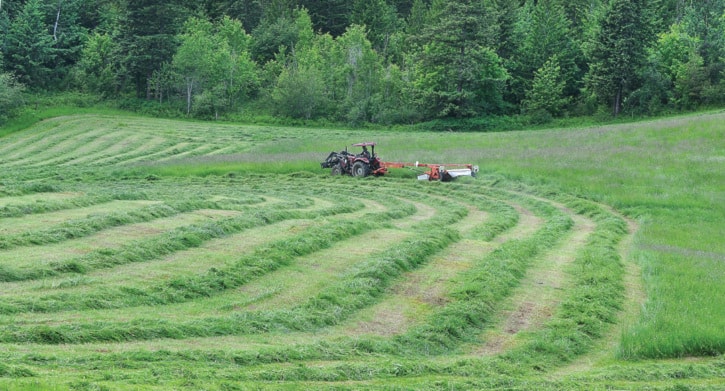Two agrologists updated Columbia Shuswap Regional District directors on the state of agriculture in B.C. and offered recommendations for steps to support local farmers and farmland.
Using a PowerPoint presentation at the June 20 board meeting, Provincial Land Use Agrologist Alison Fox and Regional Agrologist Lindsay Benbow outlined the importance of agriculture to B.C.
Fox pointed out agriculture is a significant and growing contributor to the province’s economy, with farm cash receipts increasing from $4.03 billion in 2020 to $4.56 billion in 2022. In 2023, 40,000 people were employed in primary agriculture across the province, supporting B.C. jobs and family businesses.
“It is behind oil and gas but ahead of forestry,” she said of the industry’s importance.
While noting the agriculture industry overall is a strong and stable contributor to the B.C. economy, Fox said there are several pressures on the Agricultural Land Reserve (ALR) and farming – limited agricultural land available, urbanization, housing, demographics and a lack of industrial land.
Fox said agricultural land values are the highest in Canada, with the cost of farmland in B.C. increasing by eight percent in 2022, following increases of 18.1 per cent in 2021 and eight per cent in 2020. An acre of land in the Okanagan sells for $107,000 and is up to $40,000 an acre in the Thompson-Nicola.
As more people move to B.C., housing demands increase, with more people looking at the ALR to solve housing crisis. But, Fox noted, if food security and economic benefits are priorities, the ALR cannot be the solution to B.C.’s housing crisis.
Demographics are a source of concern as well, said Fox. The average age of farmers in B.C.was 48 in 1996 but is now close to 58, and the number of people under 35 who got into farming in 2011 was 2,400 but dropped to 1,210 in 2021.
Another pressure is a critical shortage and rising cost of industrial lands in B.C., lands that provide opportunities for middle-income jobs. The lack of industrial land is putting enormous pressure on the ALR to accommodate industrial needs, Fox said.
Competing demands for limited agricultural land are growing as are the challenges for farmers.
“Ensuring greater food security requires having the land base available to support the sector,” said Fox, noting that protecting this provincial asset requires a provincial and local government effort and co-operation. “Local government elected officials can and do make a difference to support farmland, farmers and B.C.’s agricultural sectors.”
Fox closed the presentation by offering key actions local governments can take to help B.C. farmers. They include helping to create stronger buffers between farmland and other uses, enacting bylaws impacting agriculture that are consistent, fair and easy to understand and recognizing that small lots sell at a premium, rather than being affordable for farmers and new entrants.
In a question-and-answer session, Area C director Marty Gibbons complained that applications by farmers to add tourism components to their farms for extra income require a huge financial outlay.
“The government needs to make it easier,” he said, but Fox pointed to a number of cases where tourism was the focus and farming was just for show.
Area E director Rhona Martin inquired about the use of small parcels of land for things like growing strawberries and the possibility of farming up on hillsides. Fox replied that much of the hillsides are on Crown land, which are complicated by overlapping tenures such as grazing.
Area F director Jay Simpson complained that older farmers are looking to get out of the business because they can’t make a living and younger farmers find it too difficult to enter the industry. He said there is much the province can do to provide support to young farmers. Benbow pointed to a variety of programs, including the Young Agrarians, as well as assistance in creating a business plan with a consultant's assistance.
CSRD chief executive director John MacLean said in terms of housing, the province is “coming down hard” on the local government, which is trying to manage the interface between housing and the farming community.
On “the opposite side of that coin,” MacLean asked for the ministry’s view on managing the impacts of farming impacts on watershed quality. In particular, he noted fertilizers and nitrates are going into water bodies for water use on farms that impact potable water supply for homes and communities.
"What is the Ministry of Agriculture’s role in that," he asked, noting CSRD has had difficulty in getting the ministry to have a conversation around the issues without success.
But Benbow pointed out the ministry is responsible for the environmental regulations that are complaint based.
“If there are concerns with what you’re seeing, that is really where we recommend people go to that line because that is the mechanism for any type of enforcement or compliance.”
In terms of the cumulative effects of farming on the environment, MacLean said the issue is not one farmer dumping fertilizer into the water; it’s a number of farming operations doing things that traditionally might have been appropriate but are having a cumulative effect on watersheds.
Salmon Arm Coun. Tim Lavery suggested provincial educational and monitoring programs be introduced in place of the complaint-driven model.
Directors were advised the ministry is strengthening farming policies, the regional district could approach the Ministry of Agriculture, or take concerns to Pamela Alexis, Minister of Agriculture and Food, at the next Union of British Columbia Municipalities (UBCM) meeting in the fall.
